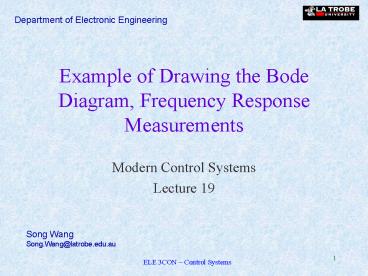Example of Drawing the Bode Diagram, Frequency Response Measurements - PowerPoint PPT Presentation
1 / 13
Title:
Example of Drawing the Bode Diagram, Frequency Response Measurements
Description:
The magnitude asymptote of the pole at ?=2 has a slope of -20dB/dec beyond the ... The magnitude asymptote for the complex poles is -40dB/dec beyond the break ... – PowerPoint PPT presentation
Number of Views:246
Avg rating:3.0/5.0
Title: Example of Drawing the Bode Diagram, Frequency Response Measurements
1
Example of Drawing the Bode Diagram, Frequency
Response Measurements
- Modern Control Systems
- Lecture 19
2
Outline
- Minimum phase transfer function
- Example of drawing the Bode diagram
- Frequency response measurements
3
Minimum phase transfer function
- A TF is called a minimum phase TF if all its
zeros lie in the left hand s-plane. It is called
a nonminimum phase TF if it has zeros in the
right hand s-plane. - The meaning of the term minimum phase becomes
clear from the following example. Suppose z,pgt0,
the TF G1(s)(sz)/(sp) has no zero in the right
hand s-plane, but TF G2(s)(s-z)/(sp) has a zero
in the right hand s-plane. - The frequency response curves can be evaluated
for real frequency sj? on the s-plane (with ?
varying along j?-axis). Thus,
4
- The amplitude characteristics of G1(j?) and
G2(j?) are the same as can be seen from
However, the phase characteristics of G1(j?) and
G2(j?) are different because
Phase characteristics for minimum phase
nonminimum phase TF
5
Asymptotic curves for basic factors
6
Example of drawing the Bode diagram
- The Bode diagram of a TF G(s), which contains
several poles and zeros, is obtained by adding
the plot due to each individual pole and zero.
For example, the TF of interest is
- The factors involved are
- A constant gain at K5
- A pole at the origin
- A pole at ?2
- A zero at ?10
- A pair of complex conjugate poles at ??n50
7
- We plot the magnitude characteristic for each
factor in the TF. - The constant gain is 20log514dB.
- The magnitude of the pole at the origin is a
straight line with a slope of -20dB/dec and
intersecting the 0dB line at ?1. - The magnitude asymptote of the pole at ?2 has a
slope of -20dB/dec beyond the break frequency
?2. - The magnitude asymptote of the zero at ?10 has a
slope of 20dB/dec beyond the break frequency
?10. - The magnitude asymptote for the complex poles is
-40dB/dec beyond the break frequency ??n50. But
the actual magnitude differs from this
approximation as ?0.3.
8
The total asymptotic magnitude can be plotted by
adding the asymptotes due to each factor, as
shown by the solid line in the figure. We can
also obtain the curve directly by plotting each
asymptote in order as frequency increases.
The magnitude characteristic of the given TF is
shown in the figure.
9
- The phase characteristic can be obtained by
adding the phase due to each factor in the TF.
- The phase of the constant gain is 00.
- The phase of the pole at the origin is a constant
-900. - We use the linear approximation of the phase
characteristic for the pole at ?2, where the
phase shift is -450 at ?2. - We use the linear approximation of the phase
characteristic for the zero at ?10, where the
phase shift is 450 at ?10. - The phase characteristic for the complex poles is
obtained from the known graph for ?0.3.
Phase characteristic
When ?46, the phase angle is -1800.
10
Summary of the example of drawing the Bode
diagram
We have drawn the approximate Bode diagram for
the TF
by finding the asymptotic magnitude and phase of
each factor. Although the magnitude and phase
curves are approximate, they give us good
indication of important frequency ranges. After
plotting these approximate curves, we can use the
equations to find the exact magnitude phase
within a relatively small frequency range, e.g.,
we are interested in the frequency at which the
phase angle is -1800. From the Bode diagram,
this occurs when ?46. Using the equation
So there is an error of 50.
11
Frequency response measurements
- Frequency response measurements can be acquired
by instruments such as wave analysers, signal
analysers, etc. From the measured frequency
response, the actual TF can be deduced. - For example, we want to determine the TF from the
Bode plot shown in the figure.
12
- Because the magnitude declines at -20dB/dec
between ?100 and ?1000. The phase is -450 and
the magnitude is -3dB at ?300. This indicates a
pole at 300. - We notice the change of the slope of the
magnitude curve at ?2450 from -20dB/dec to
20dB/dec. Also the phase angle changes rapidly
as ? increases beyond 2000, and the phase is 00
at ?2450. So we deduce that there is a pair of
complex conjugate zeros at ?n2450.
13
- contd. We also need to work out ?. This is
obtained from
by noticing the difference between the asymptotes
and the min response is 10dB. Thus,
- Because the slope of the magnitude returns to
0dB/dec as ? exceeds 50,000, we know there is
another pole. Since at ?20,000, the magnitude
is -3dB and the phase is 450(-9001800-450),
this pole is at ?20,000.
Hence, the TF is






























